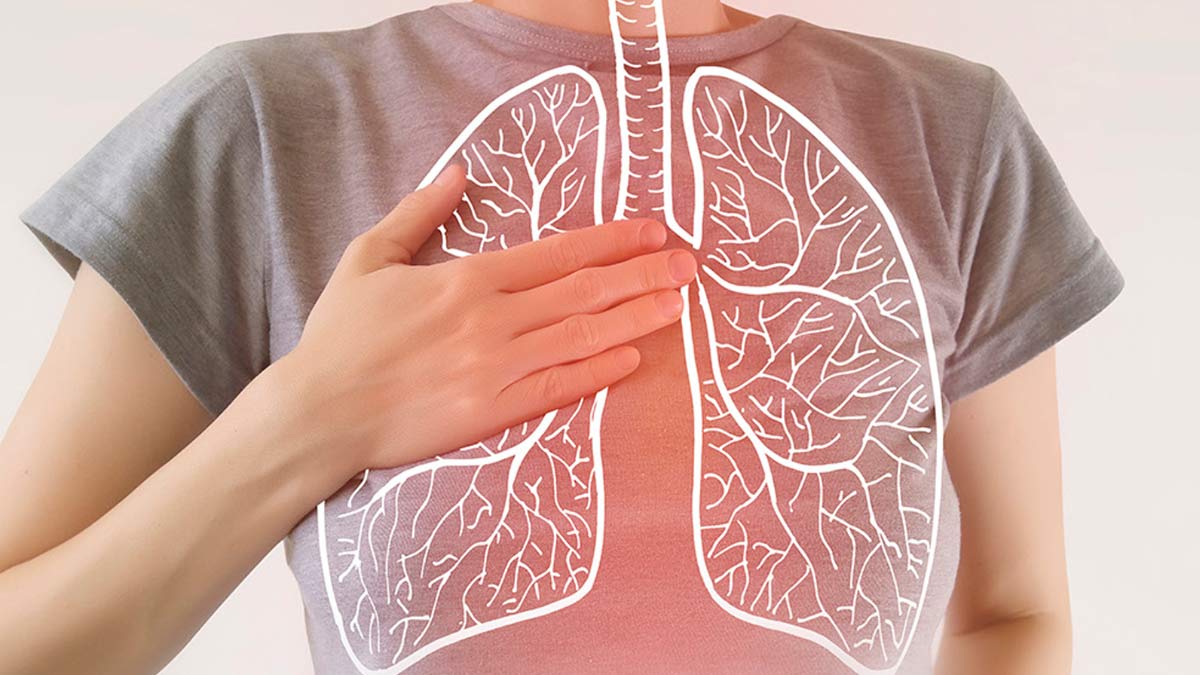Donna Cosgrove MPSI considers the characteristics of, and treatment for, the pulmonary disease COPD
INTRODUCTION AND EPIDEMIOLOGY
Chronic obstructive pulmonary disease (COPD) is a common pulmonary disease that is characterised by restricted airflow. The pulmonary component of the disease is usually progressive and is not fully reversible. Extrapulmonary effects can also be associated with COPD and can increase severity of the disease. COPD is
not curable but preventative measures and treatment options are available to manage the condition.(1) COPD is the seventh leading cause of poor health in the world, measured by disability-adjusted life years. Furthermore, it is the third leading cause of death worldwide, with the World Health Organization (WHO) estimating 3.23 million deaths caused by COPD in 2019.(2) Prevalence of COPD increases with age and is primarily present in those aged older than 40 and are smokers, with the prevalence likely underestimated due to underdiagnosis.(3) COPD is predicted to become an even greater health challenge in the coming decades.(1)
CLASSIFICATION
Emphysema and chronic bronchitis are the two most common types of COPD. Chronic bronchitis occurs when a patient has chronic cough and sputum production for at least three months per year for two consecutive years.(4) Emphysema occurs when alveoli in the lungs have been permanently damaged leading to persistent respiratory symptoms and airflow limitation.(5) Although some differences can exist between chronic bronchitis and emphysema, there is significant overlap and they often co-exist.(6)
ETIOLOGY
The development of COPD is multifactorial and includes an important interplay between both environmental and genetic factors. Alpha1-antitrypsin deficiency, a rare hereditary autosomal recessive disease, has been established as a genetic cause of COPD, particularly in younger individuals. This deficiency has been estimated as occurring in 1-2% of patients with COPD and can also lead to liver abnormalities.(7)
Cigarette smoking is the most important and prevalent risk factor for developing COPD. About 80-90% of COPD patients are estimated to be cigarette smokers or former cigarette smokers. Development of COPD and severity of symptoms can depend on smoking intensity, duration of exposure and baseline lung function. It is estimated that 10% to 15% of smokers develop COPD.(5) Indoor air pollution including second-hand tobacco smoke and biomass fuel smoke exposure are also related to the development of COPD. Other risk factors can include childhood respiratory infections, childhood asthma, maternal smoking and previously having tuberculosis. Outdoor air pollution from motor vehicles and industry, and occupational exposure to dusts and fumes can also cause an increased risk in developing COPD.(8) Additionally, low birth weight makes an individual more prone to developing COPD later in life.(5)
DIAGNOSIS
Patient medical history including symptoms, age, and smoking status should be considered in the diagnosis of COPD.(9)Spirometry is important in diagnosing COPD, as well as monitoring disease progression due to its reproducibility and objectiveness in measuring airflow limitation. Spirometry should be performed after administration of a short-acting inhaled bronchodilator. A distinctive pattern can be observed on spirometry in COPD patients, with a reduced forced expiratory volume in one second (FEV1) / forced vital capacity (FVC). A reduced FEV1 is also observed in COPD patients. Airflow limitation is defined as a post-bronchodilator FEV1/FVC lower than 0.7. In patients with a FEV1/FVC lower than 0.7, the below table shows the severity of COPD based on FEV1.(9)
Other investigations can be used in the diagnosis and differential diagnosis of COPD. Chest X-ray is not very useful in diagnosing COPD, but it is important to exclude other conditions including lung cancer and assessing for the presence of co-morbidities including pneumonia and pulmonary fibrosis. Computed tomography (CT) scans can be useful in showing anatomical changes and therefore used in patients with persistent exacerbations and patients with symptoms that don’t correspond with lung function testing. Oximetry screening for hypoxia should be carried out in patients with signs of respiratory or heart failure, with an arterial blood gases test being performed if peripheral arterial oxygen saturation is ?92%.
A full blood count can be used to rule out polycythaemia, anaemia and leucocytosis. (9) Blood testing can be used to test for Alpha1-antitrypsin deficiency, particularly in younger patients.(5) A sleep study should be performed in patients with obstructive sleep apnoea as a co-morbidity to increased risk of hospitalisation and mortality.(9) Many conditions may have to be ruled out during a differential diagnosis and these include asthma, congestive heart failure, bronchiectasis, tuberculosis, upper airway dysfunction, bronchiolitis, lung cancer, gastro-oesophageal reflux disease and ACE inhibitor-induced chronic cough.(9)
SYMPTOMS AND EXACERBATIONS
The most prominent manifestations of COPD include dyspnoea, wheezing, chest tightness, chronic cough which can be productive or non-productive, low exercise capacity and frequent bronchial infections. Symptoms
of COPD generally progress gradually.(10) Extrapulmonary manifestations are also possible in patients with COPD. These can include unintentional weight loss, skeletal muscle dysfunction, sexual dysfunction, ankle swelling and low mood. Systemic inflammation is thought to be involved in these extrapulmonary manifestations.(11)
A COPD exacerbation is defined as an acute worsening of respiratory symptoms that requires additional treatment and can last for several days. Exacerbations of COPD are a significant clinical problem due to the association with decreased lung function, lower quality of life, decreased physical activity levels, and increased mortality. Furthermore, the cost of COPD management greatly increases with an increase in COPD exacerbations. Exacerbations can be triggered by a variety of factors including air pollution, variations in outdoor temperature, and respiratory infections. Patients can sometimes experience multiple exacerbations per year, with approximately a quarter of patients experiencing two or more moderate/severe exacerbations per year. Exacerbations can be classified as mild (managed by treatment with short-acting bronchodilators), moderate (managed by treatment with antibiotics and/or oral corticosteroids) or severe (may include acute respiratory failure and can be life-threatening, with hospitalisation often required.(12)
CO–MORBIDITIES
Co-morbidities are commonly observed in patients with COPD and contribute to increased morbidity and mortality. COPD is a risk factor for lung cancer, with the risk increasing with more advanced disease. Lung cancer is the leading cause of death in patients with mild/moderate COPD. Cardiovascular disease and sleep- related breathing disorders, including sleep apnoea, are among the most common co-morbidities. Other conditions are also associated co-morbidities of COPD and include osteoporosis, depression, type 2 diabetes mellitus and metabolic syndrome. (13) It is likely that chronic inflammation plays a role in the occurrence of these associated conditions.(11)
TREATMENT
COPD is currently an incurable condition, but many treatment options to manage the disease exist. The ultimate objectives of treatment of COPD are to prevent and control symptoms, reduce the severity and number of exacerbations, to improve respiratory capacity and to reduce mortality. There is a stepwise approach to treatment and therapy should be individualised for patients. Ongoing monitoring of the condition is necessary to ensure treatment objectives are being met. Many pharmacological and non-pharmacological treatment options are used in the management of stable COPD and exacerbations. The therapeutic approach with regards to COPD also involves reducing risk factor exposure and patient education.(9)
SMOKING CESSATION
Smoking cessation and avoidance of second- hand tobacco smoke are very important in slowing the progression of COPD. (14) Smoking cessation can slow decline of lung function, and therefore reduce symptoms, hospitalisation, mortality and greatly improve quality of life.(15) While quitting smoking can be very difficult for some patients, the combination of pharmacotherapy and counselling is much more effective than either treatment option alone. Nicotine replacement therapy, bupropion and varenicline have all been shown to be effective in promoting smoking cessation. Pharmacists can advise patients on pharmacotherapy that may be suitable for them.(14) Motivational interviewing can be useful in helping people to stop smoking, which involves counselling that has the objective of helping people explore reasons that they want to quit smoking. This helps people gain confidence in their ability to change behaviours. A pharmacist is ideally placed in the community to carry out motivational interviewing to encourage patients to quit smoking.(16)
SHORT-ACTING BETA- AGONIST (SABA) AND SHORT-ACTING MUSCARINIC ANTAGONISTS (SAMA)
Bronchodilators are the mainstay of COPD treatment and can be used alone or combined with inhaled corticosteroids for greater efficacy.(17) SABAs work by acting on beta-2 receptors in the airways, which helps relax smooth muscle and provide symptomatic relief. SAMAs work by blocking muscarinic receptors on respiratory smooth muscle, which causes muscle relaxation and reduces airflow limitation. Therefore, SABAs and SAMAs have bronchodilator effects through different mechanisms of actions. SABAs and SAMAs are both effective in the treatment of exacerbations due to their rapid onset of action and can be used on an as required basis.(18) Both SABAs and SAMAs improve lung function, symptoms, and quality of life. They may be used as initial treatment in patients with mild COPD if they only have occasional dyspnoea as a symptom, while they also may be used as rescue therapy if the patient is on long-acting bronchodilator therapy. However, regular use of short-acting bronchodilators is not usually recommended. Examples of SABAs include salbutamol and terbutaline, while ipratropium is an example of an SAMA.(9)
LONG-ACTING BETA-AGONIST (LABA) AND LONG-ACTING MUSCARINIC ANTAGONISTS (LAMA)
Long-acting inhaled bronchodilators are the preferred treatment option in COPD.(17) Both LABAs and LAMAs have been shown to provide a significant improvement in symptoms, lung function and health status, while also reducing exacerbation rates. If a decision is made to use a single-agent treatment option, LAMAs may be superior
as they have been shown to be more effective in reducing exacerbations in patients with moderate to severe COPD. However, a LABA/ LAMA combination has been shown to have clinically significant improvement in lung function and health-related quality of life, without being associated with an increase in adverse effects. Guidelines recommend initiating dual therapy if a patient is still symptomatic or experiences exacerbations, despite use of non-pharmacological therapy and short-acting bronchodilator. (9) Examples of LABAs include salmeterol, formoterol, olodaterol and indacaterol. Tiotropium, aclidinium, glycopyrronium and umeclidinium are all examples of LAMAs. (17) Umeclidinium / vilanterol (Anoro), glycopyrronium / indacterol (Ultibro), tiotropium / olodaterol (Spiolto), and aclidinium / formoterol (Brimica) are all examples of LABA/LAMA combinations used in the management of COPD.(19)(20)(21)(22)
INHALED CORTICOSTEROIDS (ICS)
The use of ICS can reduce the need to use short-acting bronchodilators, reduces exacerbations and may also decrease mortality. Regular ICS treatment is indicated for patients who suffer frequent exacerbations. Studies have shown that former smokers respond better to ICS treatment than current smokers. The adverse effect profile is much more favourable with ICS than oral corticosteroid treatment, with the main adverse effects of ICS being a hoarse voice, oral thrush, and increased risk of pneumonia. Beclomethasone, budesonide, ciclesonide, fluticasone and mometasone are all examples of ICS treatment options.(9)(17)
COMBINATION PRODUCTS WITH ICS
Combination preparation of inhaled drugs is convenient and can help improve compliance in some patients. Studies have illustrated that triple therapy with LABA/LAMA/ ICS is more effective than monotherapy or double therapy with LABA/LAMA or LABA/ ICS in reducing COPD exacerbations and hospitalisation in moderate to severe COPD. Patients with COPD and have at least two moderate or one severe exacerbations in the last 12 months had reduced mortality when taking fluticasone furoate / umeclidinium / vilanterol compared to monotherapy or double therapy.(9) Fluticasone furoate / umeclidinium / vilanterol is licensed in a single inhaler called Trelegy, as a once daily dose.(23) Treatment should be reviewed after three months to assess a patient’s symptoms. The ICS may be withdrawn, and treatment changed to LABA/LAMA if no improvement in symptoms has been observed.(9)
ORAL CORTICOSTEROIDS
Oral corticosteroids can be useful in the short-term treatment of COPD exacerbations as they can provide earlier improvement in symptom relief and lung function, as well as shorten the length of a hospital stay. However, the long-term use of oral corticosteroid is not recommended due to the risk of adverse effects. These can include hypertension, osteoporosis, mood changes, thinning of the skin and Cushing’s syndrome. In some cases, patients are unable to completely stop oral corticosteroid treatment after initiation for an acute exacerbation. In these cases, the maintenance dose should be as low as possible and osteoporosis prophylaxis therapy considered.(9)(18)
PROPHYLACTIC ANTIBIOTICS
Antibiotics may be used prophylactically in the treatment of COPD. Macrolides, such as Azithromycin, are the most used antibiotics for this purpose. Azithromycin has been shown to reduce the risk of COPD exacerbations, as well as improving quality of life. Azithromycin can be considered
for individuals who had three or more exacerbations requiring oral corticosteroid treatment and at least one exacerbation requiring hospitalisation per year. Prior to commencing prophylactic azithromycin treatment, a baseline electrocardiogram (ECG) and liver function tests should be performed, as well tuberculosis testing. Long-term azithromycin treatment is associated with hearing loss which should be closely monitored. There is no data showing both the efficacy and safety of azithromycin treatment beyond one year of treatment. Prophylactic antibiotic therapy should be reviewed at both six and 12 months to determine if there is a benefit in reducing exacerbations. Treatment should be stopped if no clear benefit is observed.(9)
PHOSPHODIESTERASE-4 INHIBITORS
Phosphodiesterase-4 (PDE4) inhibitors possess both bronchodilator and anti- inflammatory effects and therefore can be useful in the treatment of COPD. Roflumilast is an oral PDE4 inhibitor that can be useful as an add-on therapy in patients that have had at least one hospitalisation due to exacerbation in the past 12 months. PDE4 inhibitors have been shown to be more effective than a placebo in improving lung function and reducing the risk of exacerbations, but they have little effect on quality of life and symptoms.(9)(24)
METHYLXANTHINES
Methylxanthine drugs are bronchodilators that act by causing respiratory smooth muscle relaxation. Aminophylline and theophylline are two methylxanthines licensed for use in Ireland. They have been shown to provide modest improvement in lung function in patients with moderate to severe COPD. However, they are not commonly used due to frequent drug-drug interactions, narrow therapeutic window, and limited potency. Methylxanthines are often only used after other treatment options have been exhausted.(9)(25)
MUCOLYTICS
Some COPD patients frequently produce a viscous sputum and mucolytics can be useful in the treatment of these patients.
Mucolytics work by reducing the viscosity of mucous and therefore aids in the clearance of mucous from the airways. Mucolytics have been illustrated to reduce the frequency and duration of exacerbations, as well as reducing the risk of hospitalisation due to an exacerbation. They don’t appear to improve lung function to a great extent, but they have the benefit of possessing a favourable safety profile.(9) Erdosteine is available on prescription, while carbocisteine is available over the counter in Ireland.(26)(27)
NON-PHARMACOLOGICAL TREATMENT
Pulmonary rehabilitation
Pulmonary rehabilitation is an important intervention for patients who are symptomatic after bronchodilator therapy. Pulmonary rehabilitation involved aerobic exercise, strength training and patient education. It is more effective when initiated early in the course of the disease. It is associated with symptom relief, improved quality of life, lower risk of hospitalisation and reduced mortality. Pulmonary rehabilitation is also associated with reduced depression and anxiety related to COPD.(9)
Oxygen therapy and ventilatory support
Oxygen therapy is recommended in COPD patients who have severe, chronic hypoxaemia. The goal of oxygen therapy is to achieve oxygen saturation levels ?90%. Patients who receive oxygen therapy at home should be fully trained, as well as their caregivers, on the safe use of all equipment. Oxygen therapy has been shown to improve exercise tolerance, quality of life, survival rates, and helps to minimise pulmonary hypertension. Ventilatory support with continuous positive airway pressure (CPAP) can improve survival rates and reduce hospitalisation in patients with both COPD and obstructive sleep apnoea.(9)
SURGICAL INTERVENTIONS
Surgery is generally the last step in the management of COPD and can include bullectomy, lung volume reduction surgery and lung transplant. Transplantation is only indicated if the patient has an unacceptable poor quality of life and clinical deterioration of disease despite all treatment options being explored, including pharmacological therapy, oxygen therapy, pulmonary rehabilitation and ventilatory support. Transplantation has been shown to improve functional capacity and quality
of life but may not improve survival rate.(9)
SELF-HELP AND LIVING WITH COPD
There are several lifestyle changes that can improve symptoms and quality of life for a patient. Patients should follow an individualised exercise plan that is tailored to their needs. Maintaining a healthy weight through a combination of regular exercise and a healthy diet is important in COPD and patients may see a dietitian as part of a pulmonary rehabilitation programme. Ensuring compliance with all prescribed medications, including inhalers, can help improve symptoms and avoid exacerbations. A patient should also have regular reviews with their specialist to monitor their condition. Patients should try to avoid certain triggers to reduce the risk of a flare-up, including dust, fumes, smoke, and other such irritants. Breathing techniques can help with breathlessness and specific techniques can be used to help clear the lungs of mucus. Finally, avoiding cold weather and periods of hot weather and high humidity can reduce the risk of exacerbations.(2)(28)
Vaccination is one of the most important preventative measures against certain viral respiratory infections. Patients with COPD are much more vulnerable to respiratory infections. Respiratory illnesses including influenza, the common cold, pneumonia, and Covid-19 are responsible for exacerbations that can greatly increase morbidity and mortality in COPD patients. Preventing respiratory infections by vaccination can improve quality of life, symptom control and patient survival. Patients with COPD should have the flu vaccination annually, receive the pneumococcal vaccine as well as having all available Covid-19 vaccinations.(29)
Reference upon request
Disclaimer: Brands mentioned in this article are meant as example only and not meant as preference to other brands.







